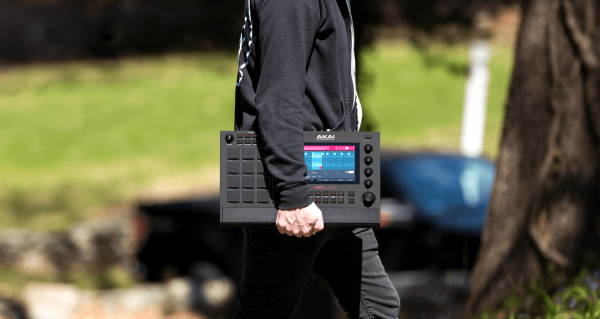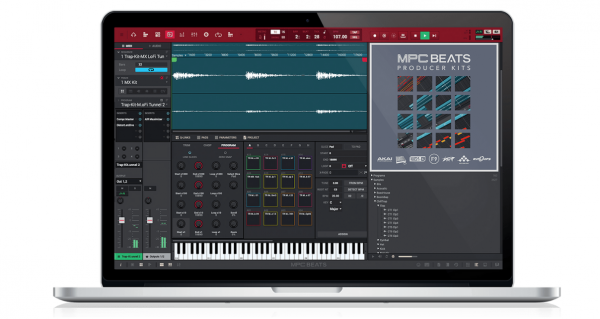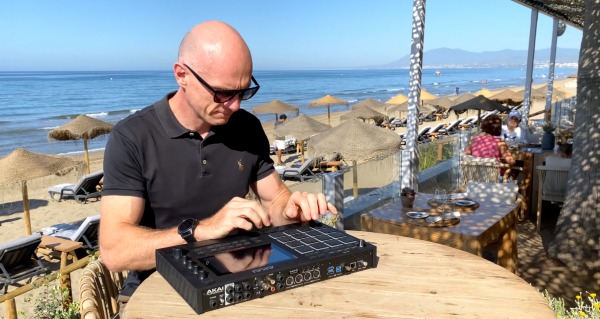The Lowdown
The Akai Pro MPC Live II is a small, well-built, professional music making machine, with everything you need in one box – even battery and speaker. You can use it to make beats, chop up and play with samples, and then assemble your “scenes” into finished tracks. It has a port for attaching a high-capacity SATA drive underneath, a phono input for plugging in a turntable for sampling, and all the plugins, sounds and more you’d expect with any DAW – all without the laptop. The learning curve feels steep, though, and for making full tracks, most people will still find a laptop easier – which is why it works with MPC Beats and Ableton Live, too.
Video Review
First Impressions / Setting up
Ever fancied buying an all-in-one music production centre to start making your own tracks?
Maybe you’re a fan of J Dilla, MadLib or other boom bap hip-hop artists, famous for chopping their samples up on MPC apps and hardware, and you’ve always wanted to buy a unit like this to have a go yourself.
After all, MPC has been there since the early days of hip hop.
Recently, though, the MPC Live II has upped Akai Pro’s game in this area.
With a unit like this, because you don’t have to use a laptop, you’re truly free to throw it in a bag and head off anywhere to make music – and yet you’ve got everything you need (sounds, samples, plugins and so on).

In the same way that DJs love Denon DJ’s little Prime GO for DJing, so it is with the Akai Pro MPC Live II – it’s the same mix of portable and professional.
Killer features on the MPC Live II include excellent integrated speakers (which they call “studio monitors”), and a phono-level line input on the back, for sampling from vinyl – with a portable turntable, this could be the ultimate portablism producer set-up for making music on the go.
Setting it up
So to start with, this unit immediately feels like a pro piece of kit.
It’s well built but not too heavy, and you get the choice of using headphones or the built-in speakers, for which there’s a switch.
The battery is fantastic – using it constantly with the speakers gives you five to six hours of play time, which is one long session of beat-making on the beach!
As you’re going to find out further on in this review, the MPC Live II is a fully fledged production centre, able to make music from first sample to finished track – so it’s good to see it’s got a slot for a SATA hard drive underneath.
Learn to make dance music with Digital DJ Tips: Dance Music Formula
All the knobs and buttons feel like they’re in exactly the right place (with some notable improvements over the MPC Live), and of course the full RGB Akai Pro pads are bright and responsive.
With everything charged and ready, I set about starting to make music with this…
In Use
Learning curve
At first, nothing here is intuitive.
Imagine having to learn MacOS or Windows, at the same time as Ableton Live, just to get started – that’s what it’s like trying to learn to use an all-in-one unit like this if you haven’t used one before.
Another analogy could be using a smartphone to do something creative for the first time, when you’ve never seen a smartphone before!

It’s not Akai Pro’s fault, and to their credit they have excellent video tutorials covering every aspect of the use of the unit, but the number of button presses, screens, sequences and so on you need to learn to get even simple things done will frustrate you at first.
Stick with it, though, and the fruits are there.
Basic jamming
For instance, a lot of people will want to use a device like this for chopping up tracks and jamming with samples and beats. And once you’ve learned how to do it, it’s really quick to just be jamming with a track that you love in this way.
I really loved a feature called “looper”, that lets you build a groove around a loop, by continually layering new sounds over the top as you go – this is addictive to use.
You can sample from a turntable via the built-in phono pre-amp, or do what I did and import tracks of your own from an SD card.
For example, my wife was playing some tunes in the car, when I heard Gladys Knight’s “Who Is She (And What Is She To You)”.
It’s one of those moments that we all have, when I thought, “Wow, there are so many great moments and samples in there – I’d love to chop that up!”
So when I got home, I got the track, put it on an SD card, put the SD card into the MPC Live II, and within seconds was sat in the garden using the built-in sampler to chop the track up and assign slices and samples to the different pads, for jamming – great fun.
Another way you can “load” this with sounds is to add some of Akai Pro’s Expansion Packs, giving you samples in many genres, often by established producers in those genres.
Structuring and mixing tracks
Of course, there’s a big difference between jamming with beats and samples and making songs, and this unit can help you with both.
Sure, it gives you the ability to jam, chop up samples, and have fun with your music away from any formal computer or studio setting, which is, as we have discussed, really cool.
But also, it is a completely pro unit able to assist you in producing full songs, without even going near a computer if you so wish, from start to finish.
Learn to make dance music with Digital DJ Tips: Dance Music Formula
Say you’ve built a few sequences – an intro, a chorus etc – just by jamming and having fun.
You can then assign those sequences to the pads, and then, rather than jamming with samples and beats, you’re jamming with the arrangement (like you would in Clip mode on Ableton Live).
Put the sequencer in Record mode, and from here you can build an arrangement of your track, live.
Then it’s on to Mix mode where you can tweak levels and apply plugins and effects globally, but also drill down to individual beats, and everything in-between, as you craft your final track.
There are a full range of plugins, effects and so on available to you – in short, the unit has a version of pretty much everything you’d find in a fully featured DAW.
In truth though, using such a small screen and workflow for these stages of song production would, to my mind, take a lot of dedication, and I can’t see many people choosing to work in this way.
Using it with a laptop
The final twist is that it can also be used with a laptop if you wish. Indeed, it may well be something on your list as a prerequisite for an all-in-one production unit like this: “What if I want to use laptop software too?”
The first way to use this with a laptop is with MPC Beats, a DAW from Akai Pro designed to work with MPC gear which has a well-featured free version to get you started. It’s basically a competitor to Ableton Live, Logic Pro and so on, and can be controlled from the MPC Live II.

If your first foray into making music was with the MPC Live II or other MPC hardware or apps, this software will feel natural to you as you switch from standalone unit to laptop and back again. The naming of things matches from hardware to software, and the integration is tight.
But it also works with the most popular dance music DAW, Ableton Live, via the Live Control option on the unit.
When working with Ableton Live, the screen becomes a representation of Ableton’s Clip view, and the unit operates as a Midi controller. It’s a little like Ableton’s Push II hardware, but with a touchscreen.
Conclusion
If you’ve read this far, you’re probably primarily a DJ, but you’re thinking of getting one of these, because it seems to offer an easy way to bring your ideas to life, in terms of making beats and chopping up samples.
And yes, it definitely is. It is absolutely the right tool to do that.
But it’s not as easy as you may think. You’ll definitely have to spend some time with it to even get anywhere. Do that, though, and you’ll soon be using it to sample beats, construct loop tracks and generally flex your groove-making muscles.
But that brings us to an important point: this unit is so much more than that. Indeed, it’d be quite an expensive purchase if you used it just to “play around” making beats.
You could justify the purchase by reminding yourself that as your music production skills grow, it’ll be many years before you need to buy any more kit (except maybe a Midi keyboard) – and again, that’s true.
But it’s worth considering that most producers opt to use a traditional DAW, for a reason.
While an experienced producer may immediately see the trade-offs you make when opting for a piece of portable gear like this, and be really excited about it, for most people, it still would be best to go down a more traditional route, at least first.
Learn to make dance music with Digital DJ Tips: Dance Music Formula
(To give you a DJ example, we love the Denon DJ Prime Go here at Digital DJ Tips, but we wouldn’t recommend it as a first DJ unit for a learner – it is too specialised.)
Learning to produce on more conventional gear would be easier, because ultimately a laptop is more comfortable for music making, and there is much more assistance out there for the established routes.
That said, the Akai Pro Youtube channel’s MPC Beats Academy does have an excellent playlist called MPC Live II, with 30 tutorials taking you from power-up to exporting your first tune.
If you’re prepared to roll your sleeves up and get stuck in, the workflow is all laid out for you there – just be aware that this isn’t the most common way people make tunes.
Read this next: 9 Reasons Why You Need To Learn Ableton Live Right Now
So while this unit won’t be for everyone, it does offer things no other gear does.
It’s truly portable, well made, has great speakers, room for a huge hard drive, a decent battery, and you can do everything on it from simple sampling to building loops to full-on production.

When it comes to jamming with the pads, it is hands-down more fun than studio software on a laptop. But don’t buy this JUST because you want a groove box – because frankly as a DJ, you could probably do that kind of thing at a push on your DJ gear.
Buy this because you want to make finished tracks, but for whatever reason really don’t want to do that (at least exclusively) by taking the traditional DAW route – or at least, you only want to use a DAW for the latter stages of the process.




